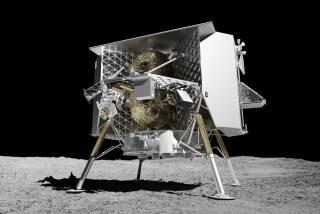A space vision crashes, burns
- Share via
LAS CRUCES, N.M. -- An attempt by video game designer-turned-rocketeer John Carmack to claim a NASA prize for designing a next-generation lunar lander ended in flames Saturday when Carmack’s experimental craft crashed in the New Mexican desert.
The liquid-oxygen-ethanol-powered craft plunged into the desert just after liftoff on the second leg of its flight, starting a small fire that was quickly doused, officials said.
Carmack, 36, the designer of the “Doom” and “Quake” video games series, said he was disappointed but pledged to return for next year’s X Prize Cup competition.
“We gave it our best shot,” said Carmack, who was surrounded by a crowd of well-wishers attending a two-day space show at Las Cruces International Airport.
The Lunar Lander Challenge offered up to $2 million in awards for teams that could launch an unmanned rocket ship, steer it to a landing spot 100 meters away, then relaunch and return to the starting point. Several private spaceflight teams planned to enter, but all dropped out except Carmack’s Armadillo Aerospace team from Texas.
His eight-man, all-volunteer team made its first attempt at the easier, $350,000 prize Friday. But the craft, named Pixel, landed hard and damaged its wiring.
After a day of repairs, Carmack was back Saturday for two more tries. The team successfully landed the craft on the first leg of its final attempt. But when the small ship lifted off for the return flight, a supporting strut gave way, pitching the craft into the chaparral.
Carmack didn’t make an attempt at the more difficult, $1-million prize, which required the ship to stay aloft for three minutes (as opposed to 90 seconds for the easier prize) and land on an uneven lunar-type surface designed by local college students.
The slight, sandy-haired Carmack said he would get to work within a few weeks on next year’s craft, which will have a different design. Instead of a squat configuration of four balloon-shaped 100-gallon fuel tanks, the next model will use a stacked component approach, similar to what NASA now uses.
“We are close” to winning the prizes, Carmack said. “I expect to crash more vehicles” before doing so, he added.
The prize money for the lunar lander event comes from NASA’s Centennial Challenge program, which is designed to encourage innovation in space technology. NASA also put up $200,000 in prize money through the Spaceward Foundation for the Space Elevator Games, which took place at the same time as Carmack’s effort.
Rules required competitors to build a “climber” capable of rapidly ascending a 200-foot-tall, 4-inch-wide carbon composite ribbon, using only beam power.
On Friday, winds frustrated several of the competing teams. But on Saturday, several of the dozen teams from around the world succeeded in making the ascent.
Only one, made up of students from the University of Saskatchewan, Canada, came close to winning the $150,000 first prize.
The team’s climber, using a bank of searchlights beamed onto solar cells that powered an electric motor, ascended in 58 seconds. It failed to descend on its own, however, and judges were deliberating whether to relax the rules and give the award to the Canadians. The competition continues today.
Even if someone comes up with a beam-powered elevator car, no one has figured out how to make a 20,000-mile-plus cable to carry the car.
More to Read
Sign up for Essential California
The most important California stories and recommendations in your inbox every morning.
You may occasionally receive promotional content from the Los Angeles Times.













